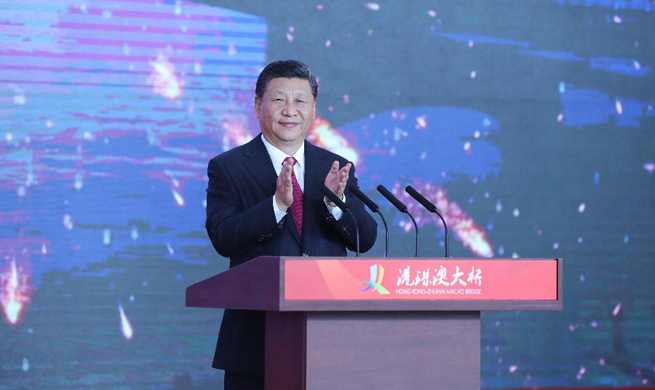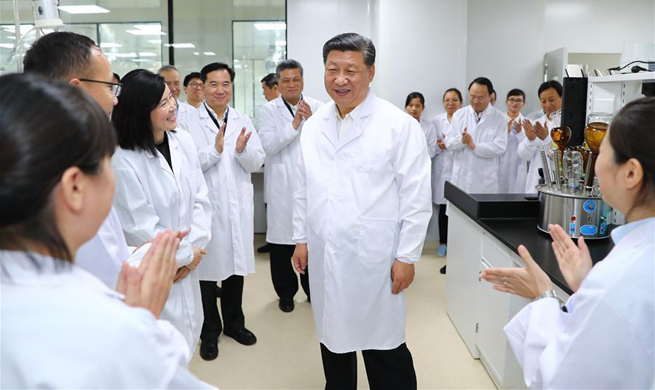by Peter Mertz
DENVER, the United States, Oct. 22 (Xinhua) -- American farmers have a long, cold winter to digest their options, but corn seeds may fill their fallow fields when spring planting begins.
Sales of soybeans to China in 2018 are already down 24.6 percent, according to U.S. Department of Agriculture (USDA) statistics released last week.
In 2017, the world's most populous nation imported 34 million tons of U.S. soybeans, followed far behind by the EU with 4.3 million tons, Mexico with 3.6 million tons, and Indonesia with 2.3 million tons. Exports to China may never be as bountiful.
"If markets and the relative prices of soybeans to corn remained as they are today, it's likely that we could see more acres shift from what was seeded in soybeans in 2018 to being seeded in corn in 2019," said Montana State University (MSU) economist Anton Bekkerman.
With soy prices dropping to decade lows, industry insiders told Xinhua that despite double dips in the closely-connected soy and corn sectors, America's heartland may see cornstalks skyrocket in 2019.
Most farmers across the country oppose the trade war started by the United States with China, and view the Trump administration's 12 billion U.S. dollar bailout as a band aid on an industry getting blasted by billions in lost revenues, with future profits in jeopardy.
An Iowa State University study last month said Hawkeye farmers alone would lose 2.2 billion dollars from the trade war, with corn and soybeans dominating field crop output.
"We're getting hit on both ends by the trade war," Montana farmer Matt Flikkema told Xinhua. "Not only are the prices of our crops dropping but we're also paying more for equipment due to the tariff on steel and aluminum."
Wheat, corn and soy prices have fallen across the board since the trade war began early this year; soy fell more than 12 percent in recent weeks.
STAGNANT SOY
In 2017, China, the world's largest soybean customer, bought 12.3 billion dollars worth of the 21.5 billion dollars soy export market, according to the U.S. Department of Agriculture (USDA).
China imposed a retaliatory, 25 percent import tax on American soybeans in July in response to U.S. tariffs on 34 billion dollars worth of China products.
"The situation for soy farmers doesn't look very promising," Bekkerman said Monday, as a prolonged trade war is expected.
Industry insiders told Xinhua that China cannot wait, needing grains for its livestock needs, and is inking deals with Brazilian farmers and seeking other international players to replace the lost American import.
"At this juncture of deepening trade tensions, it is unlikely that private traders in China would seek to buy U.S. origin soybeans," JPMorgan analysts said earlier this month.
Even worse, in America's heartland, soy storage facilities are overflowing with soy that has nowhere to go.
"The problem is that the loss of China's market has fractured the U.S. export supply chain for grains and oilseeds," Vincent Smith, a 30-year agro-economics professor at MSU, told Xinhua, stressing that the "lack of access to China's markets is causing delays in moving soybeans."
Last week, Nancy Johnson, executive director of the North Dakota Soybean Growers Association, said in a statement that 236 million bushels of soy are sitting on the shelf, with no buyer in sight.
Ironically, good weather has exacerbated the excess. In August, the USDA predicted that soy, corn and wheat harvests would reach record yields in 2018, due primarily to favorable growing conditions.
In the next few months, U.S. soy farmers will become more and more desperate to empty their vaults, industry insiders told Xinhua.
CORN TIME
Four U.S. states produce over 1 billion bushels of corn: Iowa, followed by Illinois, Nebraska and Minnesota, according to the USDA.
"Iowa has led the nation for years in growing corn," Iowa-raised farmer Ben Vandermolen told Xinhua.
America grows and exports more "maize" than any other country in the world, producing 337 million tons in 2017, followed by China with 224 million tons, Brazil with 83 million tons, and India with 42 million tons, according to Worldatlas.com.
Corn is used in a variety of products that include penicillin, whiskey, ethanol, sugar, corn silk and starch, with livestock feed and ethanol accounting for more than half of its use, according to the USDA.
Besides corn and soy, wheat is also one of America's top three export crops worth of 100 billion dollars in annual revenue, and when one commodity is affected, the others are too, economists told Xinhua.
"For wheat markets, the biggest 'spillover' is that the corn and soybean markets are likely creating a bit of a price ceiling," Bekkerman said, again underscoring China's outreach to other markets to fill its grain needs.
DISINFORMATION
Recent messages and information from the White House have farmers stunned.
Last month, U.S. President Donald Trump claimed that "soybeans are going up," and "we've had very little hurt," causing consternation in farming circles.
The U.S. president has consistently blamed "terrible trade deals" as the cause of falling farm revenue, a fact refuted by both farmers and economists.
"Trump's link between trade deals and falling prices is misplaced," said Politifact, a nonprofit project operated by the Poynter Institute in Florida, noting that soybean prices have fallen since 2012 and the main driver has been weather, like drought.
"Lower supply led to higher prices. Good weather followed, which boosted yields and pushed prices down," it noted.
Both Smith and Bekkerman, leading agro-economists, agree that "fair, free trade" is the blueprint for a "win-win" outcome for both countries.
"We need a trade deal with China," Smith said. "Not only is this foolish tit-for-tat exchange going nowhere, but it is hurting the American farmer across the board."
American farmers believe officials in Beijing are moving demand to South America and away from the United States, a trend that could be permanent.
"It takes a great deal of time to establish, develop, and maintain these trade relationships," Bekkerman said, adding "they may not come back."













